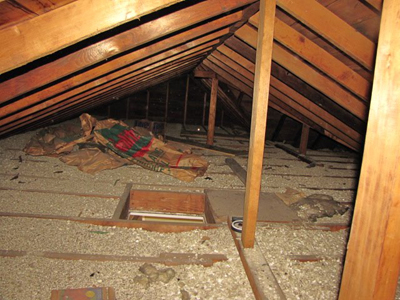
Attic Insulation Removal
There are many reasons for removal of attic insulation- could be water damage, smoke damage, animal nests or simply re-modelling
For removal of loose insulation we use an external vacuum system.
In many cases removal can be completed through the roof .
In case removal has to be completed through the hatch door, a special enclosure will be built to prevent any contamination of the house.
We can provide De-contamination services in case of animal damage.
Remediation of mold is also provided
Removal of Vermiculite Insulation Containing Amphibole Asbestos .
Please call or email to schedule free on site consultation
It’s Your Health
The Issue
Some vermiculite insulation may contain amphibole asbestos fibres. These products can cause health risks if disturbed during maintenance, renovation or demolition. However, there is currently no evidence of risk to your health if the insulation is sealed behind wallboards and floorboards, isolated in an attic, or otherwise kept from exposure to the interior environment.
Background
Vermiculite is a mica-like mineral mined around the world and used in a variety of commercial and consumer products because it is fire-resistant and has good insulation qualities. Of concern is vermiculite ore produced by the Libby Mine in Montana from the 1920’s to 1990. It was sold as Zonolite® Attic Insulation and possibly other brands in Canada during that time. Vermiculite from the Libby Mine may contain amphibole asbestos. The Libby Mine supplied the majority of the world market in vermiculite-based insulation.

Products made from vermiculite ore produced by the Libby Mine were not widely used after the mid-1980’s and have not been on the market in Canada since 1990. Not all vermiculite produced before 1990 contains amphibole asbestos fibres. However, to be safe and in the absence of evidence to the contrary, it is reasonable to assume that if your building has older vermiculite-based insulation, it may contain some amphibole asbestos.
The Health Risks Of Vermiculite Containing Amphibole Asbestos
Although the overall percentages of amphibole asbestos in bulk vermiculite are very low, the airborne percentages can increase if the material is disturbed. Asbestos poses health risks only when fibres are present in the air that people breathe. If asbestos fibres are enclosed or tightly bound in a product, for example in asbestos siding or asbestos floor tiles, there are no significant health risks. How exposure to asbestos can affect you depends on:
- the concentration of asbestos fibres in the air;
- how long the exposure lasted;
- how often you were exposed;
- the size of the asbestos fibres inhaled; and
- the amount of time since the initial exposure.
When inhaled in significant quantities, asbestos fibres can cause asbestosis (a scarring of the lungs which makes breathing difficult), mesothelioma (a rare cancer of the lining of the chest or abdominal cavity) and lung cancer. The link between exposure to asbestos and other types of cancers is less clear.
Based on current information, there is no evidence that vermiculite currently available for horticultural purposes (e.g. potting plants) is a health risk when used as directed.
Minimizing Your Risk
The best way to minimize your risk of amphibole asbestos exposure is to avoid disturbing vermiculite-based insulation in any way. If vermiculite-based insulation is contained and not exposed to the home or interior environment, it poses very little risk.
If you know you have vermiculite-based insulation in your attic, take these precautionary steps.
- Do not allow children to play in an attic with open areas of vermiculite-based insulation and make sure anyone working in the attic knows about the possible presence of amphibole asbestos.
- Do not use the attic for storage if retrieving items from it may disturb the insulation.
- If you must go into the attic, walk on boards in order to minimize disturbance of the insulation and use an appropriate respirator mask. Do not remain in the attic any longer than is necessary.
- Common dust masks are not effective against asbestos fibres. For information on appropriate respirator masks.
- If you have vermiculite-based insulation and you decide to have it removed, speak to trained and qualified asbestos removal professionals to handle the insulation removal. They can be found by looking up experts in “asbestos abatement /removal.” NEVER attempt to remove the insulation yourself.
- If you plan to remodel or renovate–for instance, by re-insulating your attic–in a manner that would disturb the vermiculite, speak to professionals who are trained and qualified to handle asbestos removal before proceeding with the work to be done.
- Seal all cracks and holes in the ceilings of the rooms below the insulation (for example, apply caulking around light fixtures and the attic hatch) to prevent insulation sifting through.
- If you suspect you have vermiculite-based insulation in your walls, as a precautionary step, seal all cracks and holes. For example, apply caulking around window and door frames, along baseboards and around electrical outlets.
Source: http://www.hc-sc.gc.ca/hl-vs/iyh-vsv/prod/insulation-isolant-eng.php
Original : March 2004
©Her Majesty the Queen in Right of Canada, represented by the Minister of Health, 2009